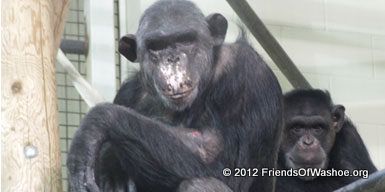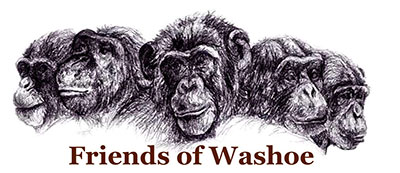June, 1966: Project Washoe Begins at the University of Reno, in Reno, Nevada

Adapted from Chapter 2 of Next of Kin, by Roger Fouts with Stephen Tukel Mills (pp. 28-29).
...Robert Yerkes, like Pepys and La Mettrie before him, theorized in his 1925 book Almost Human that "the great apes have plenty to talk about" and their silence might be overcome through sign language. This simple idea of Pepys, La Mettrie, and Yerkes had gone untested for three centuries, showing just how biased most humans are to the idea that language must be spoken. The Gardners were smart enough to acquaint themselves with chimpanzees before designing their own experiment, and a lot of the credit goes to Beatrix Gardner. Allen Gardner had earned his reputation by manipulating animal behavior in the laboratory, but Beatrix had studied ethology, the observation of animal behavior. She received her Ph.D. from Oxford University, where she was a student of the Nobel laureate Niko Tinbergen. She had spent years documenting the hunting behavior of the jumping spider.
Ethology in its best form takes a very humble approach toward nature. Theories, assumptions, and scientific dogma are put aside and instead the goal is to understand every detail of an organism's anatomy, development, and social behavior. After the Gardners studied the chimpanzee, they knew that teaching Washoe to speak vocally would be a waste of time. Sign Language, on the other hand, would fit with the chimpanzee's natural mode of communication. That breakthrough transformed ape language study from a dead end into a new frontier of communication between two species, but the Gardners also knew that they should hold on to the cross-fostering approach that had been so successful in earlier studies. Chimpanzees raised like human children were acting very much like human children, minus the language.
When ten-month-old Washoe entered her new backyard home in June 1966, she began a kind of linguistic head start program. The Gardners surrounded her with interesting friends to communicate with and an interesting world to communicate about. By the fall of 1967 there were, in addition to the Gardners, four main human companions, who would stay alert and attentive to Washoe throughout each day for the next several years.
Our job was simply to make Washoe's life as stimulating and linguistic as possible. We signed when she was eating, during her bath, and while she was being dressed. We invented exciting games, introduced new toys, books, and magazines, and made special scrapbooks of Washoe's favorite pictures-all to show ASL being used in the course of daily life. As often as possible, there were two or more of us in the yard, so that Washoe could watch us signing to each other. Above all, we were expected to form warm, affectionate relationships with Washoe.
The Gardners had no doubt that if ASL was the right language for Washoe, then she would learn to make signs to ask for food, water, and toys. However, they wanted Washoe to develop more than a vocabulary. They believed that she was not a passive laboratory subject but a primate endowed with a powerful need to learn and communicate. The Gardners wanted Washoe to ask questions, to comment on what we did, and to stimulate our conversation. They wanted her to have true two-way communication with humans.
Fouts, R. & Mills, S. T. (1997). Next of Kin: My Conversations with Chimpanzees. New York: HarperCollins.

